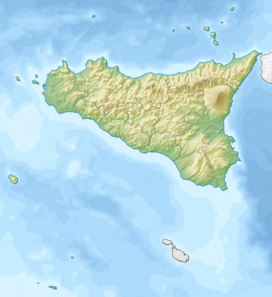
Back Etna Afrikaans Ätna ALS Mont Etna AN Eþna ANG جبل إتنا Arabic جبل اتنا ARZ Etna AST Etna Azerbaijani Bulkan Etna BCL Этна Byelorussian
| Mount Etna | |
|---|---|
 Etna with the city of Catania in the foreground (December 2007) | |
| Highest point | |
| Elevation | 3,403 m (11,165 ft)(varies)[1][2][3] |
| Prominence | 3,403 m (11,165 ft)[1] Ranked 54th |
| Isolation | 998.79 km (620.62 mi) |
| Listing | Ultra |
| Coordinates | 37°45.3′N 14°59.7′E / 37.7550°N 14.9950°E[2] |
| Naming | |
| Native name | Muncibbeḍḍu (Sicilian) |
| Geography | |
Metropolitan City of Catania, Sicily, Italy | |
| Geology | |
| Rock age | 350,000 – 500,000 years |
| Mountain type | Stratovolcano |
| Last eruption | June 7th, 2024 [4] |
| Criteria | Natural: viii |
| Reference | 1427 |
| Inscription | 2013 (37th Session) |
| Area | 19,237 ha |
| Buffer zone | 26,220 ha |
Mount Etna, or simply Etna (Italian: Etna [ˈɛtna] or Mongibello [mondʒiˈbɛllo]; Sicilian: Muncibbeḍḍu [mʊntʃɪbˈbɛɖɖʊ] or 'a Muntagna; Latin: Aetna; Ancient Greek: Αἴτνα and Αἴτνη[5]), is an active stratovolcano on the east coast of Sicily, Italy, in the Metropolitan City of Catania, between the cities of Messina and Catania. It is located above the convergent plate margin between the African Plate and the Eurasian Plate. It is one of the tallest active volcanoes in Europe,[6] and the tallest peak in Italy south of the Alps with a current height (September 2024) of 3,403 m (11,165 ft),[1] though this varies with summit eruptions. For instance, in 2021 the southeastern crater reached a height of 3,357 m, but was then surpassed by the Voragine crater after the summer 2024 eruptions.[7]
Etna covers an area of 1,190 km2 (459 sq mi) with a basal circumference of 140 km (87 miles). This makes it by far the largest of the three active volcanoes in Italy, being about two and a half times the height of the next largest, Mount Vesuvius. Only Mount Teide on Tenerife in the Canary Islands surpasses it in the whole of the European–North-African region west of the Black Sea.[8]
In Greek mythology, the deadly monster Typhon was trapped under this mountain by Zeus, the god of the sky and thunder and king of gods, and the forges of Hephaestus were said also to be underneath it.[9]
Mount Etna is one of the world's most active volcanoes and is in an almost constant state of activity. The fertile volcanic soils produced from this activity support extensive agriculture, with vineyards and orchards spread across the lower slopes of the mountain and the broad Plain of Catania to the south.[10] Due to its history of recent activity and nearby population, Mount Etna has been designated a Decade Volcano by the United Nations.[11] In June 2013, it was added to the list of UNESCO World Heritage Sites.[12]


- ^ a b c "Il cratere Voragine dell'Etna cresce, bordo supera 3.400 metri - Notizie - Ansa.it". Agenzia ANSA (in Italian). 18 September 2024. Retrieved 19 September 2024.
- ^ a b The elevation varies with volcanic activity. The volcano last erupted 21 May 2023. It is frequently given as 3,350 m (10,990 ft), but many sources that support this concede that this is approximate. The coordinates given, which are consistent with SRTM data, are from a 2005 GPS survey. The elevation data are based on a LIDAR (Light Detection and Ranging) survey carried out in June 2007, see Neri, M.; et al. (2008), "The changing face of Mount Etna's summit area documented with Lidar technology", Geophysical Research Letters, 35 (9): L09305, Bibcode:2008GeoRL..35.9305N, doi:10.1029/2008GL033740
- ^ Pezzella, Francesca. "L'Etna si supera. Nuovo record di altezza a 3357 metri". www.ingv.it (in Italian). Archived from the original on 10 August 2021. Retrieved 10 August 2021.
- ^ "Mount Etna erupts dramatically, sending ash 4.5 kilometers high".
- ^ Suda, alphaiota, 375
- ^ "Etna & Aeolian Islands 2012 – Cambridge Volcanology". www.volcano.group.cam.ac.uk. October 2012.
- ^ Laura Geggel (16 August 2021). "Mount Etna is 100 feet taller than it was 6 months ago". Space.com.
- ^ "Italy volcanoes and Volcanics". USGS. Archived from the original on 1 July 2011.
- ^ Aelian, Hist. An. xi. 3, referenced under Aetnaeus in William Smith's Dictionary of Greek and Roman Biography and Mythology
- ^ Thomaidis, Konstantinos; Troll, Valentin R.; Deegan, Frances M.; Freda, Carmela; Corsaro, Rosa A.; Behncke, Boris; Rafailidis, Savvas (2021). "A message from the 'underground forge of the gods': history and current eruptions at Mt Etna". Geology Today. 37 (4): 141–149. Bibcode:2021GeolT..37..141T. doi:10.1111/gto.12362. ISSN 1365-2451. S2CID 238802288.
- ^ "Decade Volcanoes". United States Geological Survey.
- ^ Mount Etna Becomes a World Heritage Site, Italy Magazine, 4 May 2013

